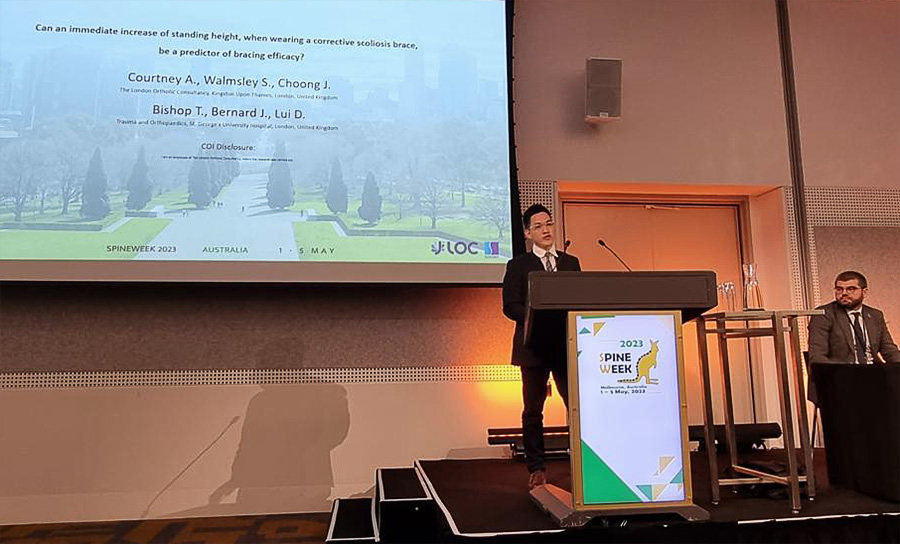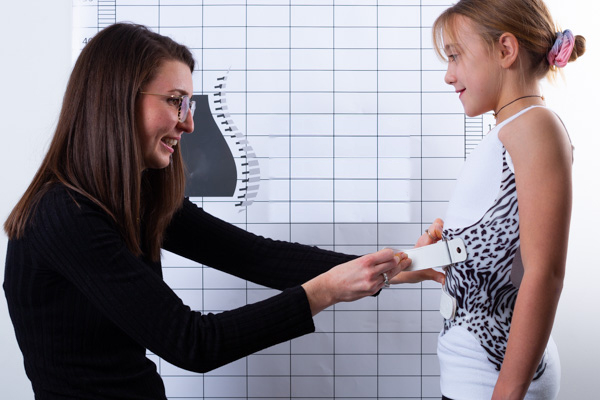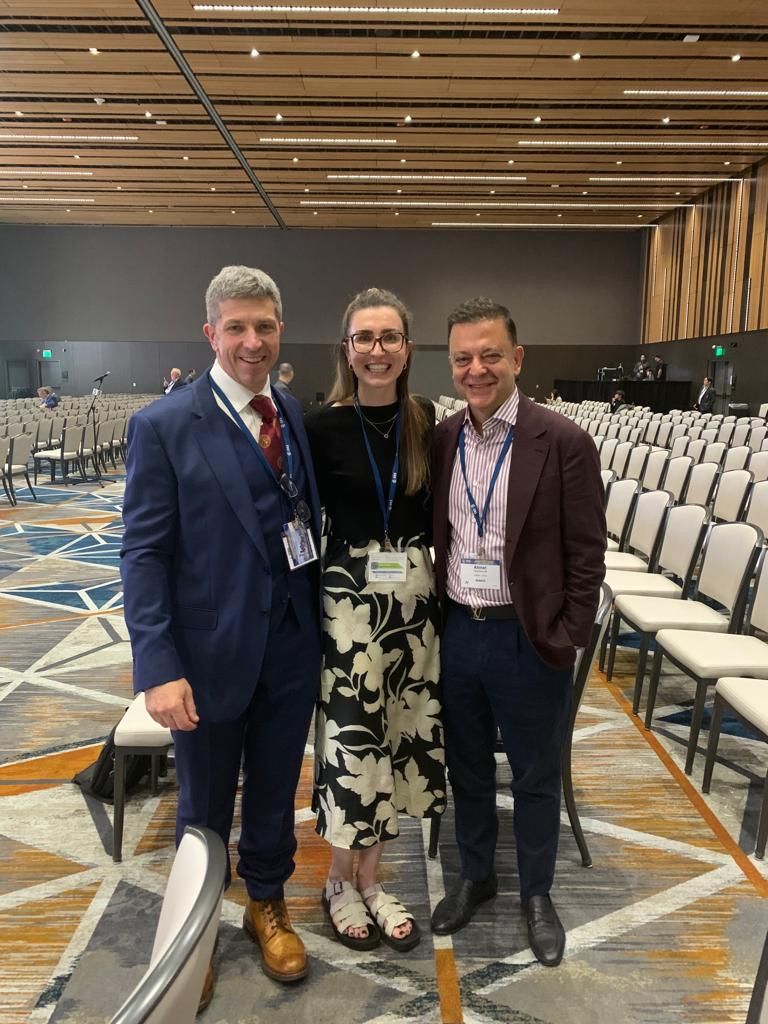Since commencing its scoliosis treatment, the London Orthotic Consultancy has established itself as a clinic at the very forefront of scoliosis brace design. As such, we are now in a position with the LOC Scoliosis brace where our work is being internationally recognised as pioneering in terms of brace design, development and the levels of correction we can achieve.
Since we launched the LOC Scoliosis Brace in 2022, we have been collecting continuous data from all our scoliosis patients who consent to participate and we have conducted this research alongside St George’s University Hospital London.
As a result, we have been invited to present our research and clinical findings at several leading conferences worldwide, aimed at conservative as well as surgical treatment of scoliosis. The most eminent of which has been The Scoliosis Research Society, the leading international body dedicated to scoliosis research.
Below you can find a detailed list of the conferences where we have presented our clinical findings.

Senior orthotist Jack Choong presents scoliosis clinical research findings from the London Orthotic Consultancy at Spine Week 2023 Conference in Melbourne, May 2023

Anna Courtney, Clinical Lead Consultant & Senior Orthotist fitting a LOC Scoliosis Brace
In 2023, The London Orthotic Consultancy was invited to participate in the NHS BASIS study (Bracing Adolescent Idiopathic Scoliosis Study).
This long-term study is currently scheduled to continue until 2031. It has been designed by surgeons, scoliosis patient representatives and researchers to try to further the evidence surrounding scoliosis bracing.
More than twenty hospitals across the UK are involved and young people aged 10-15 years old with a diagnosis of scoliosis are being asked to participate in this randomised controlled trial.
The objective of the study is to compare two different types of back brace, one which is worn most of the day and one which is worn only at night time. A version of the LOC Scoliosis Brace will be prescribed and fitted to the night-time group.
Read more about LOC’s involvement in the study
Courtney et al. RF127: On-site clinician-led bracing algorithm with short clinical feedback loops lead to significant improvements in bracing outcomes. Rapid Fire. Global Spine Journal. 2024;14(4_suppl):208S-362S. doi:10.1177/21925682241239518
Courtney et al. P435: Assessing the presentation of adolescents seeking bracing treatment in the UK, using SRS bracing guidelines. E-Posters. Global Spine Journal. 2024;14(4_suppl):363S-689S. doi:10.1177/21925682241239483
Global Spine Congress, Bangkok, May 2024. The London Orthotic Consultancy’s Scoliosis team will travel to Bangkok in May 2024 to begin the next round of education and discussions at the leading world-class spine congress which gathers thousands of worldwide spinal surgeons.
Scoliosis Research Society, Seattle, September 2023. Can an immediate increase of standing height, when wearing a corrective scoliosis brace, be predictive of in-brace skeletal correction? Courtney A, Walmsley S, Lui D, Bishop T, Bernard J. The London Orthotic Consultancy, Kingston Upon Thames, United Kingdom; Trauma and Orthopaedics, St. George’s University Hospital, London, United Kingdom.
The British Scoliosis Society, Liverpool, November 2023. Assessing the presentation of adolescents seeking bracing treatment in the UK, using SRS bracing guidelines. Courtney A, Walmsley S, Choong J, Lui D, Bishop T, Bernard J. The London Orthotic Consultancy, Kingston Upon Thames, United Kingdom; Trauma and Orthopaedics, St. George’s University Hospital, London, United Kingdom.
The British Scoliosis Society, Liverpool, November 2023. On-site clinician-led bracing algorithm with short clinical feedback loops lead to significant improvements in bracing outcomes. Courtney A, Walmsley S, Choong J, Lui D, Bishop T, Bernard J. The London Orthotic Consultancy, Kingston Upon Thames, United Kingdom; Trauma and Orthopaedics, St. George’s University Hospital, London, United Kingdom.
The International Society on Scoliosis Orthopaedic and Rehabilitation Treatment, Spine Week, Melbourne, May 2023. Can an immediate increase of standing height, when wearing a corrective scoliosis brace, be predictive of in-brace skeletal correction? Courtney A, Walmsley S, Choong J, Lui D, Bishop T, Bernard J. The London Orthotic Consultancy, Kingston Upon Thames, United Kingdom; Trauma and Orthopaedics, St. George’s University Hospital, London, United Kingdom.
The International Society on Scoliosis Orthopaedic and Rehabilitation Treatment, Spine Week, Melbourne, May 2023. Assessing the presentation of adolescents seeking bracing treatment in the UK, using SRS bracing guidelines. Courtney A, Walmsley S, Choong J, Lui D, Bishop T, Bernard J. The London Orthotic Consultancy, Kingston Upon Thames, United Kingdom; Trauma and Orthopaedics, St. George’s University Hospital, London, United Kingdom.
The International Society on Scoliosis Orthopaedic and Rehabilitation Treatment, Spine Week, Melbourne, May 2023. On-site clinician-led bracing algorithm with short clinical feedback loops lead to significant improvements in bracing outcomes. Courtney A, Walmsley S, Choong J, Lui D, Bishop T, Bernard J. The London Orthotic Consultancy, Kingston Upon Thames, United Kingdom; Trauma and Orthopaedics, St. George’s University Hospital, London, United Kingdom.
The British Scoliosis Society, Edinburgh, November 2022, Can an immediate increase of standing height, when wearing a corrective scoliosis brace, be predictive of in-brace skeletal correction? Courtney A, Walmsley S, Lui D, Bishop T, Bernard J. The London Orthotic Consultancy, Kingston Upon Thames, United Kingdom; Trauma and Orthopaedics, St. George’s University Hospital, London, United Kingdom.
LOC has found the prognostic model validated by this study of immense benefit when evaluating new adolescent idiopathic scoliosis patients:
Lori A. Dolan, Stuart L. Weinstein, Mark F. Abel, Patrick P. Bosch, Matthew B. Dobbs, Tyler O. Farber, Matthew F. Halsey, M. Timothy Hresko, Walter F. Krengel, Charles T. Mehlman, James O. Sanders, Richard M. Schwend, Suken A. Shah and Kushagra Verma. Spine Deform. 2019 Nov; 7(6): 890–898.e4.
This study aims to fill the gap in prognostic models for untreated Adolescent Idiopathic Scoliosis (AIS). It successfully develops and validates a model using the Simplified Skeletal Maturity System, offering reliable risk estimates for curve progression. This has significant implications for comparative studies and assists clinicians and families in making informed treatment decisions.

Senior Orthotist and Lead Scoliosis Consultant Anna Courtney at the Scoliosis Research Society Conference in Seattle, Washington in September 2023, alongside Orthopaedic Consultants at St George's University Hospitals NHS Foundation Trust.
There is an increasing body of evidence detailing the enormous benefits that 3-dimensional bracing (based on Cheneau principles) in tandem with Schroth-based therapy offers in the treatment of scoliosis.
Below you can find links to a series of research papers that discuss the efficacy of this approach in treating scoliosis and avoiding spinal surgery.
Bettany-Saltikov J, Turnbull, D, Ng, SY, Webb, R. Open Orthop J. 2017 Dec 29;11:1521-1547. eCollection 2017.
The review evaluates the up-to-date evidence for the treatment of spinal deformities, including scoliosis and hyperkyphosis in adolescents and adults.
Excerpt from conclusion: "There is at present high-quality evidence in support of the conservative treatment of AIS. The current evidence supports the use of PSSE, especially those using PSSR, together with bracing in the treatment of AIS. In view of the lack of medical consequences in adults with AIS, conservative treatment should be considered for curves exceeding the formerly assumed range of conservative indications."
Weiss HR, Seibel S, Moromarco M, Kleban A. Hard Tissue 2013 Nov 25;2{5}:43
This study of 21 patients proves that asymmetric braces allow better in-brace correction than symmetric braces and that in turn results in optimal improvements to curvatures, even in curves exceeding 45 degrees.
View paper
Weiss HR & Monomarco M. Hard Tissue 2013 Feb 26;2{2}:14
This paper compares the case studies of three patients with curvatures exceeding 45 degrees with a plethora of literature on the subject which had shown limited evidence of improvements via bracing.The case studies indicate that trunk and back shape can be improved by bracing, even in patients with curvatures exceeding 45 degrees. For the majority of scoliosis patients with curvatures exceeding 45 degrees, surgery should not be indicated, considering that a large percentage of long-term effects are detrimental, as shown in the literature.
Weiss HR. OA Musculoskeletal Medicine 2014 May 03;2{1}:10
This is a review of the literature with respect to the outcome of Cheneau brace treatment. The end results of the latest two independent trials indicate a success rate of over 95%
Weiss HR. & Goodall. D. European Journal of Physical Rehabilitation and Medicine 2008, 44:177-93
This review provides a synopsis of all treatment options for idiopathic scoliosis, including a review of short-term studies which support outpatient physiotherapy. No controlled study was found to support surgical intervention as a treatment for idiopathic scoliosis and cites the unknown long-term effects of surgery as a factor.
Weiss HR & Goodall, D. Scoliosis 2008, 3:9.
This paper looks at the limitations of spinal fusion surgery in preventing progression, restoring ‘acceptability’ of the deformity and reducing curvature. This paper concludes that scoliosis surgery has a varying but generally high rate of complications, though long-term risks have not yet been reported on and further research is needed.
Weiss HR & R. Klein. Pediatric Rehabilitation, July 2006; 9(3): 190–200.
This paper tests the hypothesis that physio-logic® exercises improve the outcome of Scoliosis Intensive Rehabilitation (SIR) by correcting the deformity in the sagittal plane.
University of Alberta. ScienceDaily. ScienceDaily, 25 January 2017.
A new study shows specialized physical therapy exercises can improve the curve of the spine, muscle endurance and quality of life, as researchers advocate for conservative management to be added to the standard of care for patients in Canada.
* Scoliosis Journal, 2016 “Among all PSSE approaches, Schroth [14] is among the most studied and widely used specific exercise approaches for scoliosis.”
The LOC Scoliosis Brace is a 3D, hypercorrective, Cheneau-Gensingen derivative brace, known as one of the most corrective and modern scoliosis braces available in the UK. It is designed to:
The brace is entirely unique and tailored to the patient’s spinal curve pattern, ensuring optimal skeletal correction while prioritising comfort.
Unlike traditional braces, it opens from the front for easier self-application and maintains a low profile under clothing.
The LOC Scoliosis Brace is worn 22 hours a day (including nighttime) and works in conjunction with Schroth-based therapy for maximum results.
As adults have reached skeletal maturity and the vertebrae are no longer malleable, an orthotic brace is unlikely to be able to correct the existing Cobb angle of the patient. However, LOC prescribes bespoke back braces to reduce posture-related pain and improve appearance and posture.
The operation used to treat severe scoliosis curves is typically spinal fusion surgery; a major procedure that involves moving muscles and realigning the skeleton into place. The curved, deformed vertebrae are fused together into a single bone, putting metal screws and rods into the spine to help straighten it. Surgery typically lasts between 4 and 8 hours depending on the severity of the curve. Bone graft is then taken from other parts of the body and used to cover the implants.
Following the operation, it is necessary to spend around a week in intensive care before returning home and the first few days are often uncomfortable. Most adolescents can expect to return to school from 2-4 weeks following surgery, but pain medication may be required up to 6 weeks following. A full recovery from the procedure can take up to a year, as it can take that long for the spine to heal fully.
Spinal fusion surgery causes the fused portion of the back to become permanently stiff, as a result, returning to sports that require large amounts of flexibility (ballet, yoga, gymnastics, dance) or contact (rugby, football, karate, hockey) may take longer.
Risks of spinal fusion surgery are like that of any other major procedure and include infection, blood clots and anaesthesia complications. The added risks include permanent nerve damage to the spine and paralysis.

“It’s life-changing, my swimming coach has even remarked what a difference my treatment has made" Read how pectus bracing treatment helped to correct Aris' complex chest deformity, involving a combination of pectus excavatum, pectus carinatum and rib flaring.

Cerebral palsy patient Lucas sees significant improvement in his walking after only six months in his new custom Ankle Foot Orthoses (AFOs), designed by Professor Saeed Forghany in our Manchester clinic. Hear how a detailed gait analysis and bespoke AFOs significantly improved Lucas's gait and comfort.

Freddie’s positional plagiocephaly was treated successfully with the LOCBand Lite, going from 11mm to 2mm after four months in his helmet.

Adult club foot (talipes) patient Natasha says, "I cannot stress how amazing my AFOs are and how they have changed so much for me. The support they give me allows me to walk without crutches outside the house for the first time in over fifteen years."

Diagnosed with adolescent idiopathic scoliosis at 14 years old, Polly and mum Zoe looked to the LOC Scoliosis Brace to help her curve and avoid surgery at a later date.

LOC opens its first clinic in Northern Ireland, LOC Belfast, offer non-surgical orthotic treatment for scoliosis, pectus carinatum and pectus excavatum. Here, we will also be able to provide orthotic treatments for a range of adult and paediatric lower limb conditions including cerebral palsy, spina bifida, hypermobility, stroke, post-polio syndrome, and multiple sclerosis.

Mum Natalie shares her experience of having both her identical twins diagnosed with craniosynostosis. Ella and Nina had surgery at Great Ormond Street Hospital before going through cranial remoulding therapy at the London Orthotic Consultancy.

See how a thorough gait analysis and a correctly-fitted, bespoke Reciprocating Gait Orthosis (RGO) helped Ted, a spinal surgery and cancer survivor, improve his rehabilitation and mobility goals, getting him back on his feet again.